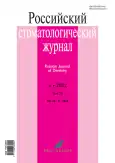Frenula of tongue and lips: are there or not?
- Authors: Aleksandrova O.V.1
-
Affiliations:
- Sechenov First Moscow State Medical University (Sechenov University)
- Issue: Vol 26, No 3 (2022)
- Pages: 191-197
- Section: Clinical Investigation
- URL: https://journal-vniispk.ru/1728-2802/article/view/84476
- DOI: https://doi.org/10.17816/1728-2802-2022-26-3-191-197
- ID: 84476
Cite item
Abstract
BACKGROUND: The absence, hypoplasia, or hyperplasia of the frenula of the lips and tongue is suggested as a sign of some diseases. This study assessed the presence of frenula among patients with orthodontic concerns.
AIM: This study aimed to analyze the prevalence of the absence of the frenulum of the tongue and lips to determine the possibility of using the absence of frenula as a diagnostic criterion for other pathologies.
MATERIALS AND METHODS: A retrospective analysis photographs of 391 patients was performed.
RESULTS: In total, 100% of the patients have a maxillary frenulum. The inferior labial frenulum was absent in 67.02% of the patients, and 252 patients (95% CI 62.27–71.77%) had multiple strands of the mucosal membrane. Hypoplastic mandibular frenulum was found in 109 (28.99%) patients (95% CI 24.4–33.58%). Absence of lingual frenulum was noted in 6 (1.68%) patients (95% CI 0.35–3.01%) and hypoplasia in 33 (9.24%) (95% CI 6.24–12.24%).
CONCLUSIONS: The absence of inferior labial and lingual frenulum cannot be a diagnostic criterion for other pathologies without specifying the method of displacement of the lower lip.
Full Text
##article.viewOnOriginalSite##About the authors
Olga V. Aleksandrova
Sechenov First Moscow State Medical University (Sechenov University)
Author for correspondence.
Email: aleksandrovastom@yandex.ru
ORCID iD: 0000-0002-0160-1698
Russian Federation, Moscow
References
- Petrovsky BV, editor. Encyclopedic dictionary of medical terms. Vol. 3. Moscow: Sovetskaya entsiklopediya; 1984. P:1241–1242. (In Russ).
- Devishree GSK, Shubhashini PV. Frenectomy: a review with the reports of surgical techniques. J Clin Diagn Res. 2012;6(9):1587–1592. doi: 10.7860/JCDR/2012/4089.2572
- Telebaeva GT, Sharipova SK. Abnormal lip and tongue frenulum: classification, terminology approach to diagnostic. Bulletin of the Kazakh National Medical University. 2014;(2):107–111 (In Russ).
- Odolskiy AV. Comparative analysis of excision techniques of labial and tongue frenulums, mucous membrane bands using a surgical scalpel and diode laser. Medical Bulletin of the Ministry of Internal Affairs. 2013;(3):78–79 (In Russ).
- Iwanaga J, Takeuchi N, Oskouian RJ, Tubbs RS. Clinical Anatomy of the Frenulum of the Oral Vestibule. Cureus. 2017;9(6):e1410. doi: 10.7759/cureus.1410
- Chu MW, Bloom DC. Posterior ankyloglossia: a case report. Int J Pediatr Otorhinolaryngol. 2009;73(6):881–883. doi: 10.1016/j.ijporl.2009.02.011
- Mills N, Pransky SM, Geddes DT, Mirjalili SA. What is a tongue tie? Defining the anatomy of the in-situ lingual frenulum. Clin Anat. 2019;32(6):749–761. doi: 10.1002/ca23343
- Mills N, Geddes DT, Amirapu S, Mirjalili SA. Understanding the lingual frenulum: histological structure, tissue composition, and implications for tongue tie surgery. Int J Otolaryngol. 2020:1820978. doi: 10.1155/2020/1820978
- Martin RA, Jones KL. Absence of the superior labial frenulum in holoprosencephaly: a new diagnostic sign. J Pediatr. 1998;133(1):151–153. doi: 10.1016/S0022-3476(98)70198-2
- Mintz SM, Siegel MA, Seider PJ. An overview of oral frena and their association with multiple syndromic and nonsyndromic conditions. Oral Surg Oral Med Oral Pathol Oral Radiol Endod. 2005;99(3):321–324. doi: 10.1016/j.tripleo.2004.08.008
- De Felice C, Toti P, Di Maggio G, et al. Absence of the inferior labial and lingual frenula in Ehlers-Danlos syndrome. Lancet. 2001;357(9267):1500–1502. doi: 10.1016/S0140-6736(00)04661-4
- Böhm S, Martinez-Schramm A, Gille J, Behrens P. Missing inferior labial and frenula in Ehlers-Danlos syndrome. Lancet. 2001;385(9293):1647–1648. doi: 10.1016/S0140-6736(01)06684-3
- Shankar S, Shirley E, Burrows NP. Absence of inferior labial or lingual frenula is not a useful clinical marker for Ehlers-Danlos syndrome in the UK. J Eur Acad Dermatol Venereol. 2006;20(10):1383–1384. doi: 10.1111/j.1468-3083.2006.01736.x
- De Felice C, Di Maggio G, Zagordo L, et al. Hypoplastic or absent mandibular frenulum: a new predictive sign of infantile hypertrophic pyloric stenosis. J Pediatr. 2000;136(3):408–410 doi: 10.1067/mpd.2000.103506
Supplementary files









